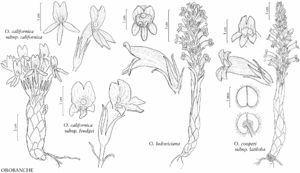Orobanche ludoviciana
Gen. N. Amer. Pl. 2: 58. 1818.
Plants simple or few-branched, 7–40 (–54) cm, usually stout, base enlarged in robust specimens. Roots inconspicuous to conspicuous (often forming an amorphous mass), slender, usually branched. Leaves several to numerous, appressed; blade lanceolate to lanceolate-ovate, 5–10 mm, margins entire, apex acute, surfaces sometimes glandular-pubescent. Inflorescences spikelike racemes, purple, lavender, or pallid distally, rarely yellow, sometimes branched, glandular-pubescent; flowers numerous; bracts ± reflexed, lanceolate, 8–12 mm, apex acute or attenuate, densely glandular-pubescent. Pedicels 0–15 mm, much shorter than plant axis; bracteoles 2. Flowers: calyx purple, lavender, or pallid, weakly bilaterally symmetric, 8–14 mm, deeply divided into 5 lobes, lobes lanceolate-subulate, glandular-pubescent; corolla 14–20 mm, tube white to pallid or cream, sometimes pinkish or light purplish tinged distally, sometimes with purple veins, constricted above ovary, slightly curved forward, glandular-pubescent; palatal folds prominent, yellow, pubescent; lips externally white to pallid or cream, sometimes pinkish or light purplish tinged, internally pink or purple, sometimes white with purple veins, rarely light yellow, abaxial lip spreading, 3–5 mm, lobes oblong-lanceolate, apex obtuse or rounded, adaxial lip erect or slightly reflexed, 4–6 mm, lobes ovate, sometimes deltate, apex rounded or obtuse to bluntly pointed; filaments glabrous or pilose at base, anthers included or slightly exserted, glabrous or with few woolly hairs along sutures. Capsules ovoid, 6–13 mm. Seeds 0.3–0.5 mm. 2n = 48.
Phenology: Flowering Apr–Aug.
Habitat: Prairies, sand hills, sand dunes, eroded ground, glades, roadsides.
Elevation: 0–2500 m.
Distribution
Alta., B.C., Man., Sask., Colo., Idaho, Ill., Kans., Minn., Mo., Mont., Nebr., N.Mex., N.Dak., Okla., S.Dak., Tex., Wash., Wis., Wyo.
Discussion
Orobanche ludoviciana is one of the most widely distributed species of Orobanche in North America. It commonly occurs in wind and water eroded habitats, principally in the Great Plains of North America and contiguous areas.
Throughout most of its range, Orobanche ludoviciana parasitizes Grindelia squarrosa and several species of Artemisia. However, at the southern limits of the range in Texas, it has been reported on Baccharis, Haploësthes, Heterotheca, and Thelesperma (Asteraceae); in Canada, Heterotheca villosa is an important host. The reports on cultivated crops (tomato and tobacco) are the result of misidentifications by P. A. Munz (1930) and should be attributed to O. cooperi and O. riparia.
The binomial Orobanche ludoviciana has often been broadly applied to several taxa in western states, including several taxa treated herein as species.
P. A. Munz (1930) inadvertently used a specimen of Orobanche riparia to describe and illustrate the corollas of O. ludoviciana as having pointed corolla lobes. This led him to include several western taxa that have pointed corolla lobes within O. ludoviciana, including taxa treated here as species: O. cooperi, O. riparia, and O. valida. L. T. Collins et al. (2009) clarified this issue, pointing out that the corolla lobes are in fact rounded.
Selected References
None.
